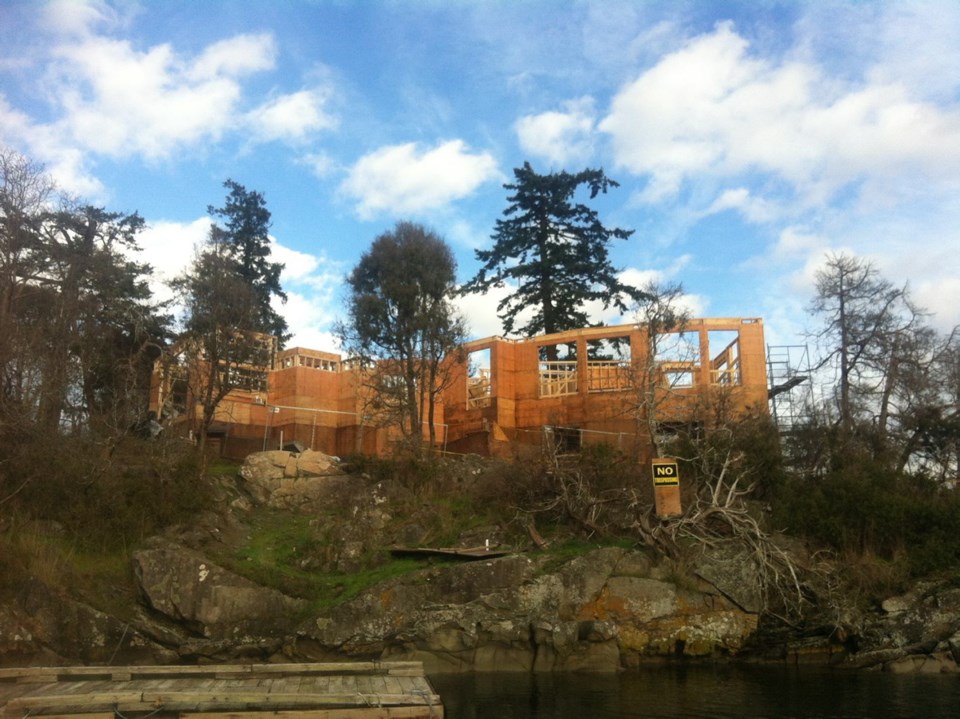It has taken months for the provincial government to respond to public outcry over a luxury home being built on a First Nations cemetery on Grace Islet, near Saltspring Island.
Now, a notice of title claim has been announced by Cowichan Tribes and the Ministry of Forests has confirmed it has a mandate to resolve the issue with First Nations and the landowner. It has also appointed two mediators to work with landowner Barry Slawsky and First Nations leaders.
“We’ve been trying to work with the ministry and landowner but now it’s at the point where we are moving to assert aboriginal title and rights to this land,” said Cowichan Tribes Chief William Seymour.
He said Minister Steve Thomson called to tell him about the mandate and the mediators, but Seymour was cautious about whether it will lead to action.
“It’s come to a point where we’ve been forced into this,” said Seymour, noting the law firm Woodward and Co. are representing the band. He said the claim is meant to right a government wrong, not set any precedent for asserting rights on private land.
The claim states that by granting private ownership of Grace Islet, the Crown infringed on aboriginal title over an area exclusively occupied by Cowichan prior to contact, a known burial site and registered archeological site. It claims descendants of the Cowichan Nation are entitled to the land.
“Elders from the beginning have talked about Ganges being a known harvest area. There is a very good possibility they have direct ancestors buried there [on the islet],” Seymour said.
The Tribes, seven bands in the Cowichan Valley area, are one of several local First Nations groups with an interest in Grace Islet and who have said they are pursuing legal action. A group of advocates from Saltspring Island has raised more than $9,000 for the Penelakut First Nation to seek a legal opinion on protection of the islet.
Slawsky, an Alberta businessman, bought the small island from the previous landowner in 1990. In 2006, exposed human remains were found on the islet by kayakers and determined to be ancient bones. First Nations burial cairns were also identified by archeologists and the islet was deemed a cemetery.
In B.C., burial grounds established before 1846 fall under the Heritage Act, not the protection of the Cemeteries Act.
Slawsky obtained site alteration permits from the archeological branch (in the forests ministry) to continue building.
But permit violations and claims of grave desecration, such as building on top of cairns, incited protests from First Nations, local governments and the public.
Slawsky is out of the country and could not comment on the legal action or what kind of resolutions he’d be open to. His Victoria-based lawyer, John Alexander, said he is not involved in his client’s dealings with the province but was aware the parties had met. If the aboriginal title claim was to be filed, it could have huge implications for British Columbians and sway public sentiment against First Nations, Alexander said.
“It would be the first direct aboriginal title claim of private land,” he said. “It will certainly drive away investment and alarm homeowners.”
Gary Holman, MLA for Saanich North and the Islands, has been pressing the government to act on Grace Islet for years.
“They say they’re talking, but as they’re talking the house is being built,” Holman said.
Holman spoke to Thomson a few days ago and was told that while the province cannot expropriate the land for public use under the heritage act, it might be able to do so under different legislation.
“They say they have a mandate, which is good. But how are they going to act on it?,” Holman said.
Thomson’s office said it had no comment as discussions were ongoing.



